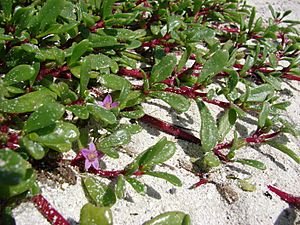Sesuvium portulacastrum facts for kids
Quick facts for kids Sesuvium portulacastrum |
|
|---|---|
 |
|
| Scientific classification | |
| Genus: |
Sesuvium
|
| Species: |
portulacastrum
|
| Synonyms | |
|
Synonymy
Portulaca portulacastrum L. 1753
Aizoon canariense Andrews 1802 not L. 1753 Aizoon montevidense Spreng. ex Rohr Halimus maritima Kuntze Halimus portulacastrum (L.) Kuntze Mollugo maritima Ser. Psammanthe marina Hance Pyxipoma polyandrum Fenzl Sesuvium acutifolium Miq. Sesuvium brevifolium Schumach. & Thonn. Sesuvium edule Wight ex Wall. Sesuvium longifolium Humb. & Bonpl. ex Willd. Sesuvium ortegae Spreng. Sesuvium parviflorum DC. Sesuvium pedunculatum Pers. Sesuvium pentandrum Elliott Sesuvium repens Willd. Sesuvium revolutifolium Ortega Sesuvium revolutum Pers. Sesuvium sessile Pers. Sesuvium sessiliflorum Dombey ex Rohrb. Trianthema americana Gillies ex Arn. Trianthema polyandra Blume |
|
Sesuvium portulacastrum is a cool plant often called shoreline purslane. It's a type of herb that spreads out and grows in coastal areas all over the world. People in the Philippines call it dampalit.
Contents
About Shoreline Purslane
Shoreline purslane is a plant that lives for many years. It can grow up to 30 centimeters (about 12 inches) tall. Its stems are thick and smooth, and they can spread out for up to 1 meter (about 3 feet) long.
Leaves and Flowers
The leaves of shoreline purslane are smooth and fleshy. They are a shiny green color. The leaves can be from 10 to 70 millimeters long (about 0.4 to 2.7 inches). They are also 2 to 15 millimeters wide (about 0.08 to 0.6 inches). The flowers of this plant are usually pink or purple.
How Shoreline Purslane Got Its Name
The famous scientist Carl Linnaeus first described this plant in 1753. He first named it Portulaca portulacastrum. Six years later, in 1759, Linnaeus moved it to a different group of plants called Sesuvium. It has been known as Sesuvium portulacastrum ever since.
Where Shoreline Purslane Grows
Shoreline purslane grows in many parts of the world. You can find it in sandy soil, coastal areas with limestone and sandstone, and even in salty marshes. It is naturally found in Africa, Asia, Australia, North America, and South America. It has also started growing in many other places where it was not originally found.

Special Uses of the Plant
Scientists have studied Sesuvium portulacastrum. They found that it contains different kinds of natural chemicals. Some of these chemicals might help fight against certain types of germs. This means the plant could be useful in medicine.
Shoreline Purslane as Food
People in the Philippines eat Sesuvium portulacastrum. They call it dampalit in the Tagalog language. In other parts of the Philippines, like the Visayan region, it's called "bilang" or "bilangbilang." People often pickle the plant. They make a sweet and sour traditional pickle called atchara with it.
See also
 In Spanish: Sesuvium portulacastrum para niños
In Spanish: Sesuvium portulacastrum para niños

